Advertisement
Decluttering Your Home Is Easy—And Dare We Say Fun?—With This Guide

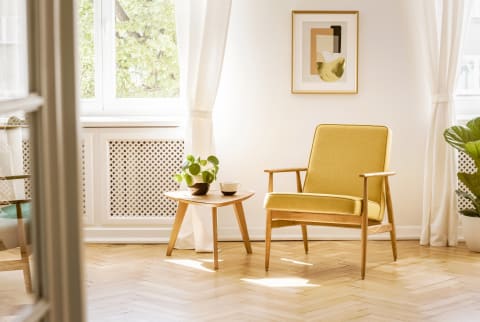
Purge alert! There are plenty of reasons the declutter bug can strike—all of a sudden your junk drawer sends you into a frenzy, your horoscope tells you to clean up your act, or maybe you just binge-watched Tidying Up With Marie Kondo on Netflix—whatever the catalyst, take it as a clutter-free call to action and get started.
But where to begin? Most of us know the benefits of decluttering—it can make you less stressed, happier, and even emotionally healthier—it's the "how-to's" that can lead to declutter paralysis. Help! To get you started, here's an action plan for each room to keep you on task.
The entryway
The house's main artery can quickly turn into a dumping ground for discarded shoes and junk mail if you let it. Do you really need more than one jacket or pair of shoes by the door? Donate or put away extras. Next, create a drop spot for daily essentials, like keys, sunglasses, or purses.
"Having a dedicated space for these items, whether it's an entryway table or a few hooks on the wall, will save you from searching for misplaced keys every morning," says professional organizer Elsa Elbert, founder of Composed Living.
Another rule of thumb: "To ensure this space stays clutter-free, take care of your mail before putting it down," says Elbert. That means immediately opening anything of importance and recycling any junk mail.
The living room
The living room gets a lot of use but doesn't always offer traditional storage—which is probably why remotes and blankets are always hanging around. "Keeping your living room surfaces clutter-free is essential for an inviting space, so containment is key," says Elbert, who suggests using baskets to house extra blankets, store magazines, or hide your little one's toys. "Decorative boxes are great for storing necessities like remotes, while a gorgeous tray works well on a coffee table to both display your favorite objects and make moving them out of the way easier," she adds. Here are some beautiful home storage tools professional organizers swear by.
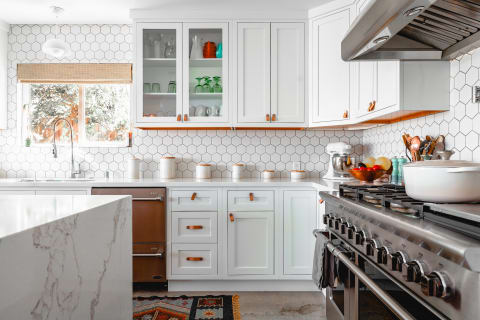
The kitchen
Unlike the living room, which is lacking drawers and shelves, the kitchen is nothing but, which can turn it into a black hole of unused gadgets and gizmos. "Creating stations by grouping similar items together allows you to see everything you own and makes finding your cooking essentials a breeze," says Elbert, who suggests storing rarely used appliances in hard-to-reach cabinets and installing pullout drawers to maximize space in pantries and lower cabinets. Donate storage containers without matching lids, dishes you no longer use, and cookie cutters collecting dust to free up space.
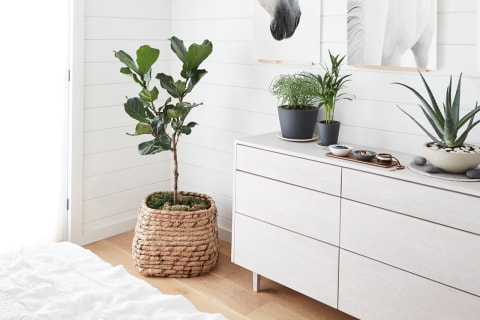
The bedroom
You want to sleep in a sanctuary, not a tsunami of strewn clothes. Since an unmade bed can make the whole room feel messy, start there. Tackle your nightstand next, trash mystery chargers, toss dried-up pens, and put already-read books back on the shelf. Your M.O. going forward: "Put your clothes away immediately, whether it's clean laundry or your outfit at the end of the day," says Elbert. "By taking the time to put your things where they belong, you'll keep the space tidy—and you'll be less inclined to buy new items when you can't find what you need."
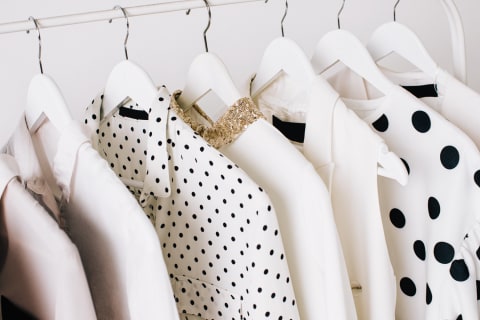
The closets
Reframe your closets. Whether they're for clothes, linens, or a utility closet, instead of looking at them as just a place to put stuff, see them as an organizing tool. That means hanging clothes by type (pants, shirts, fancy dresses), separating supplies by category (light bulbs, wrapping supplies), and organizing linens by kind (towels, sheet sets, blankets). "Limit yourself to two sets of sheets for each bed in your home and two towels for each person," suggests Elbert.
Going forward, keep your bedroom closet under control by doing a seasonal detox. "As the seasons change, so do your wardrobe needs. Take a few moments to eliminate anything that no longer fits, physically or stylistically, and move any out-of-season garments to the harder-to-reach parts of the closet," says Elbert.
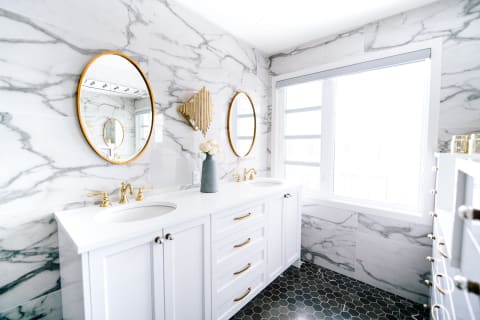
The bathroom
While the bathroom isn't a room for obvious clutter, those vanity drawers and beauty cabinets can house some sneaky culprits. So what's your first step? "Go through all makeup, skin care, and hair products—only keep what you use," suggests Elbert. Next, eliminate expired1 medications and contain items by type (e.g., a bin for makeup, first-aid supplies, medications). Tip: "Don't take the mini toiletries from hotels or accept cosmetic samples from department stores unless you truly use them," says Elbert.
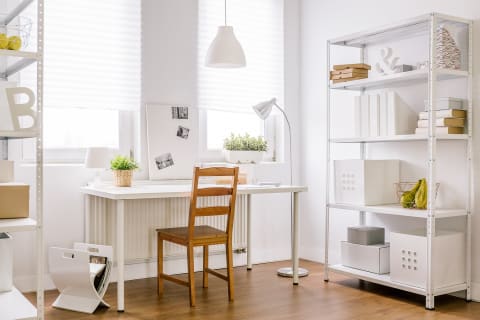
The home office
Need extra incentive to tackle your home office? Less clutter can boost productivity. Start by figuring out what you actually need on your desk. Keep only the stuff you use daily up top, and move secondary supplies (scissors, paper clips, rubber bands) to a drawer organizer. Those paper piles come next. "File any paperwork you must keep, or consider scanning your items to eliminate the paper clutter," says Elbert. "And get in the habit of clearing off your desk at the end of every day to keep clutter from accumulating."
General rules to live by when you're decluttering.
Now that you have a room-by-room action plan, here are some expert tips to keep in mind as you declutter your home and life.
1. Start slow.
Elbert stresses the fact that that decluttering can be exhausting, both physically and emotionally—so take things slow. Set a goal of 30 minutes per day when getting started. If you're feeling really energized, shoot for one room per day.
2. If nothing else, pay attention to your bedroom.
If you're unsure where to start your decluttering process, the bedroom is probably a safe bet. After all, being surrounded by clutter can majorly stress us out when we're trying to sleep. Professional organizer and author Tracy McCubbin actually recommends keeping books and magazines out of the bedroom for this reason. There's nothing like a minimalist space that's free of distractions to quiet your mind at the end of a busy day.
3. Be equipped with the right storage.
Before you get started clearing your space, invest in a few storage boxes so your keepers will have somewhere to live. No need to be fancy here! In fact, according to organizer Francesca Verri Gove, you can't beat a simple clear shoe shoe box bin. "It simplifies the storage solution; it is practical, clear (so you can see what is in it), stackable, inexpensive, and small enough that you won't keep more than you need," she says.
4. Think of your life like a museum exhibit.
This tip from London-based simple living advocate Tara Button may sound funny at first, but it actually makes a lot of sense. When put on your curation hat and approach your home like it's a new exhibit, suddenly all those things that you're holding on to "just in case" start to lose their appeal. Surround yourself with items that reflect who you are and where you want to go—and nothing more.
5. Follow the 80% rule.
As you're figuring out what still deserves a spot in your space, remember this tip from Clea Shearer and Joanna Teplin, the duo behind The Home Edit: No part of your home should be more than 80% full. "You have to respect the amount of space you have. It's like with eating: Nobody is comfortable at 100 percent max fullness," Shearer says. "Constantly respect the space. Constantly go through it." A little breathing room can go a long way!
6. Get rid of things right away.
Marie Kondo's process may be a little too restrictive for some organizers, but most can agree with her idea that we should be getting rid of things that don't spark joy. Once you have your to-go pile, Kondo says the next step is to actually get rid of it! Right away. That way, there's no chance your belongings sit in the corner for weeks—or worse, end up back in your home. Which brings us to the next point...
7. Dispose of everything responsibly.
While it can be tempting to take all your old stuff to the dump and call it a day, do the planet a favor and try and find a second home for it first. Charity shops are one option, as are secondhand retail websites like ThredUp for clothes and AptDeco for furniture. Listing your items on freeby sites like Freecycle is another way to find them a happy second home.
8. Remember that nobody is grading you at the end of this.
The next time you find yourself buried in a pile of old paperwork, take a deep breath and remember: Perfection isn't the goal here. Hoarder-turned-minimalist Eve O. Schaub put it perfectly when she wrote, "I made a deal with myself: I promised to forgive myself for the inevitable 'mistakes' that were bound to crop up. I tried to remember that, in life, it's rare to make decisions that are clearly 'right' or 'wrong' and to remind myself that there won't be anyone waiting around with a red pencil to give me a letter grade on how I did at the end."
9. To keep things clean, follow this golden rule.
To keep yourself from feeling the need to declutter every six months, follow the one-in-one-out rule. "At this point, anything new that comes in is likely replacing something else. If I'm inspired by something out in the world—let's say a vintage, chunky wool sweater—I'll get rid of a sweater that has been loved and is ready to move on to a new owner," pro declutterer Kyle Quilici says of how she keeps her own studio apartment feeling tidy.
10. ... And designate a drop-off zone.
"Have a place for items that can't get put away right now: A basket in the kitchen for mail, a bin for miscellaneous toys, etc," cautions organizer Bonnie Dewkett. "When life gets busy and you can't pick up every day, it's important to have a place where things can go to get off the floor. Then, when you have more time, empty these receptacles."
Happy organizing!
Watch Next
Enjoy some of our favorite clips from classes
Enjoy some of our favorite clips from classes
What Is Meditation?
Mindfulness/Spirituality | Light Watkins
Box Breathing
Mindfulness/Spirituality | Gwen Dittmar
What Breathwork Can Address
Mindfulness/Spirituality | Gwen Dittmar
The 8 Limbs of Yoga - What is Asana?
Yoga | Caley Alyssa
Two Standing Postures to Open Up Tight Hips
Yoga | Caley Alyssa
How Plants Can Optimize Athletic Performance
Nutrition | Rich Roll
What to Eat Before a Workout
Nutrition | Rich Roll
How Ayurveda Helps Us Navigate Modern Life
Nutrition | Sahara Rose
Messages About Love & Relationships
Love & Relationships | Esther Perel
Love Languages
Love & Relationships | Esther Perel

















